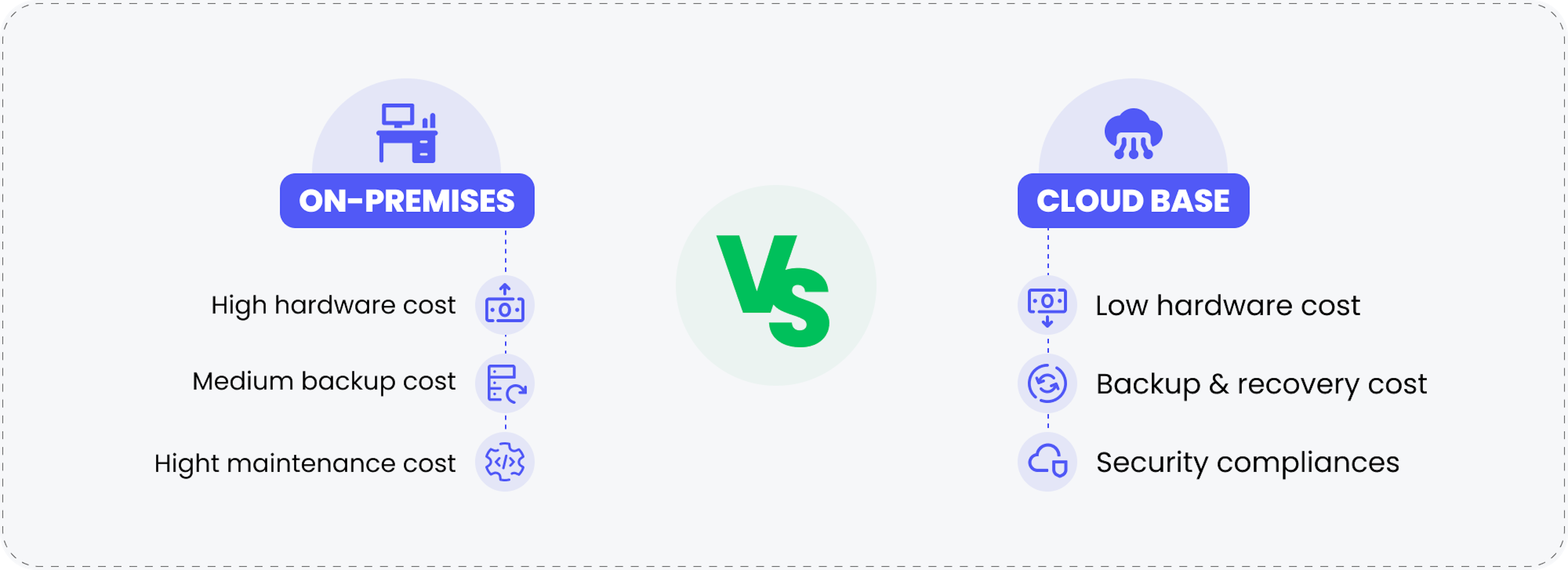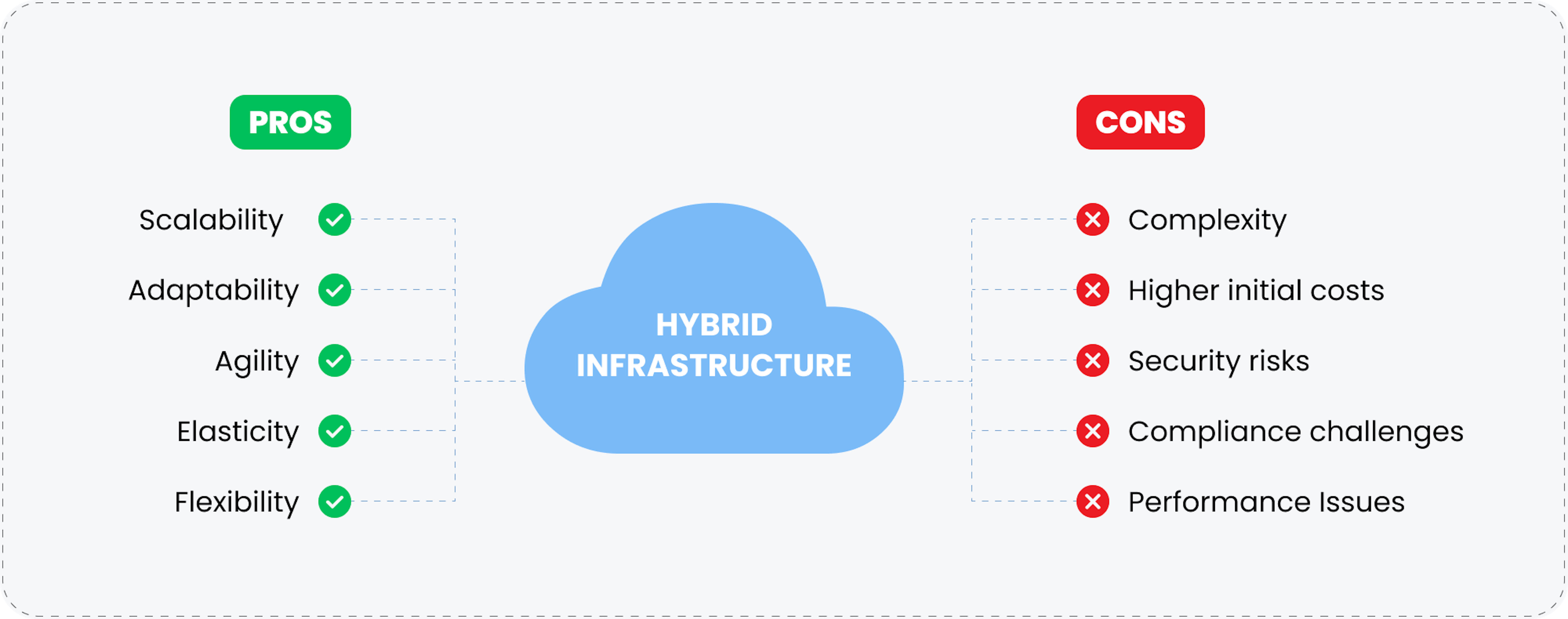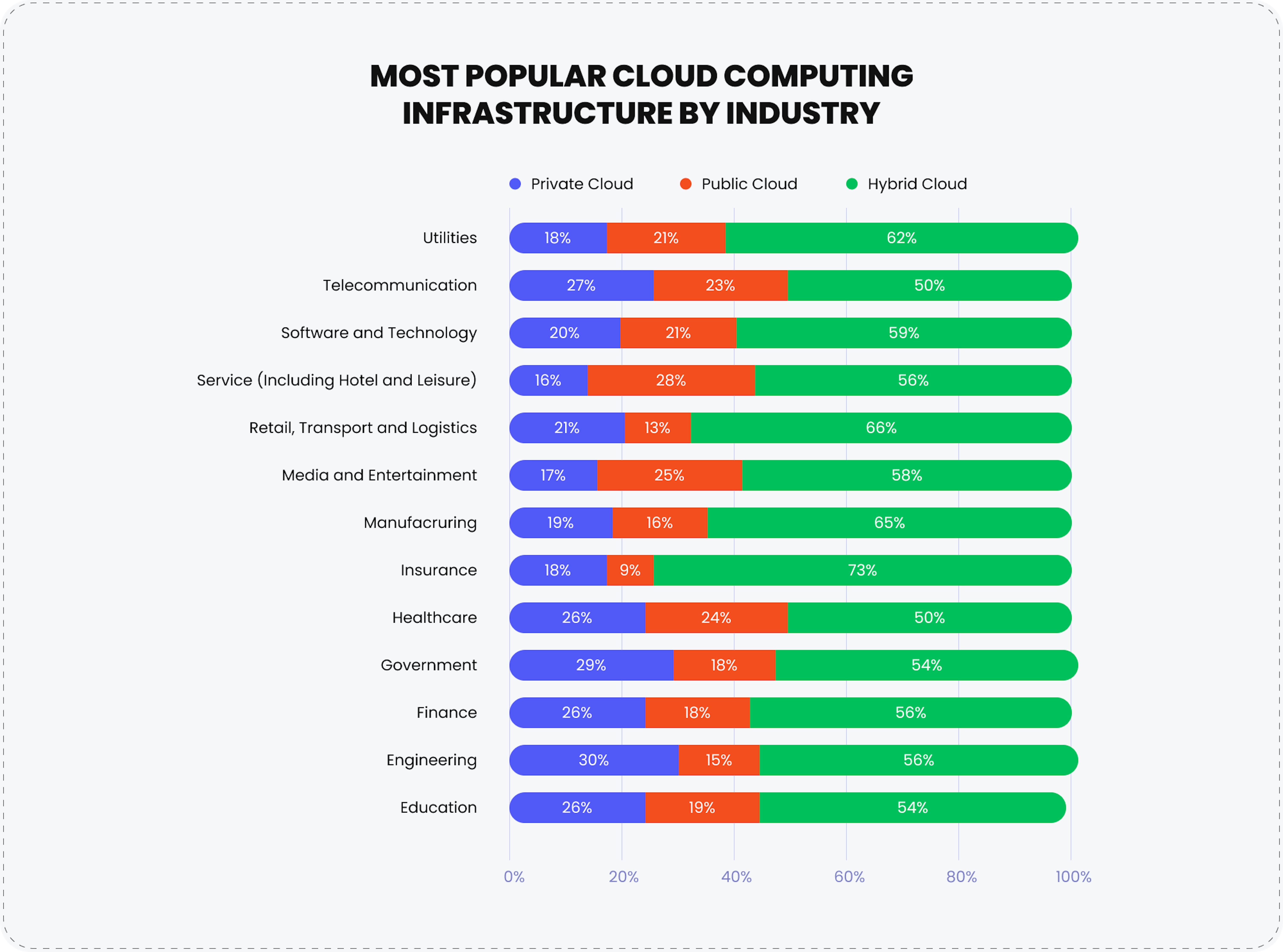When it comes to managing, storing, and processing data and applications, businesses often face a critical choice between on-premises and cloud computing solutions. Each approach comes with its unique advantages and challenges, making it vital to evaluate their differences thoroughly.
In this article, we'll break down the key features, benefits, and trade-offs of on-premise and cloud computing, empowering you to make the best decision for your business needs.

On-premise: advantages and disadvantages
The on-premise model represents the traditional approach to IT asset management, where all resources—software, hardware, and infrastructure—are hosted and managed within the organization's physical facilities. In this setup, the organization takes full ownership of the IT environment, from deployment to maintenance.
With everything running on your premises, company's administrators have complete control over the infrastructure. This eliminates reliance on third parties and enables organizations to implement stringent security measures to protect their sensitive data.
Many organizations, particularly in industries with high security or compliance demands, continue to rely on on-premise solutions. For example, IBM utilizes on-premise solutions like the IBM Operational Decision Manager and IBM Cloud Pak for Business Automation to manage complex computing environments, enabling precise control over business rules and processes. Or Microsoft employs on-premise business management systems, such as Dynamics 365 Finance + Operations, within its own data centers to support essential business processes
Advantages of on-premise software
Opting for on-premise software comes with distinct benefits, particularly for businesses prioritizing control, security, and independence:
➕ Enhanced security
Hosting systems and data on a private infrastructure ensures full control over sensitive information. Without involving third-party providers, organizations can implement and manage robust security mechanisms tailored specifically to their needs, maintaining strict confidentiality and minimizing external risks.
➕ Simplified compliance
On-premise environments allow businesses to directly monitor and enforce compliance with industry regulations and internal standards. This hands-on control ensures that all necessary requirements are met without relying on cloud providers to handle compliance on their behalf, simplifying audits and providing greater confidence in meeting regulatory obligations.
➕ Independence from Internet connectivity
On-premise systems are not reliant on external networks or remote data centers. This minimizes risks associated with internet outages or regional disruptions, ensuring reliable access to critical systems and data.
Disadvantages of on-premise software
While on-premise solutions provide enhanced control and security, they have significant challenges. Managing IT resources locally places operational and financial demands on organizations, making them less flexible than cloud-based alternatives. Key disadvantages include:
➖ High maintenance burden
On-premise systems require your IT team to handle all aspects of maintenance, including software updates, hardware repairs, and regular data backups. These responsibilities can consume significant time and resources, detracting from strategic initiatives.
➖ Limited scalability
Scaling on-premise infrastructure to match fluctuating demands is inherently challenging. Surges in demand can strain resources, while periods of low demand may result in underutilized hardware, leading to inefficiencies and wasted investment.
➖ Significant upfront costs
Deploying on-premise software involves substantial initial costs, including purchasing hardware, software licenses, and setting up infrastructure. This capital expenditure is often higher than the cloud's pay-as-you-go model, which spreads costs over time.
➖ Inflexible resource allocation
On-premise systems lack the agility of cloud solutions. Rapidly scaling resources to accommodate shifting business needs can be time-intensive and costly, limiting the organization's ability to adapt to changing circumstances.
Cloud computing: advantages and disadvantages
Cloud computing relies on third-party providers to host and manage data and infrastructure. Businesses pay a subscription fee for the resources they use, eliminating the need to purchase and maintain hardware or employ dedicated IT staff.
The cloud provider oversees infrastructure maintenance, including backups and updates, allowing businesses to focus on their operations. Accessible via the internet, cloud services enable remote work and flexibility in scaling operations.
Major cloud service providers include:
- Amazon Web Services (AWS) — The largest cloud provider, offering a wide range of services, from compute power to machine learning.
- Microsoft Azure — A popular choice for enterprises, providing seamless integration with Microsoft tools and services.
- Google Cloud Platform (GCP) — Known for its data analytics, machine learning, and AI capabilities.
📖 Learn more about securing your cloud environment with our related article "Multi-Cloud Security Best Practices"
Advantages of cloud computing
Cloud computing provides businesses with a range of benefits, including cost savings, flexibility, and efficiency:
➕ Instant provisioning
Resources are provisioned quickly, bypassing lengthy setup times, as cloud providers maintain pre-configured servers ready for use.
➕ Reduced costs
Businesses save on hardware, data centers, and IT staffing costs. With a pay-as-you-go model, organizations only pay for the resources they consume. According to Accenture, migrating to the public cloud can lower the total cost of ownership (TCO) by up to 40%.
➕ Automatic maintenance
Cloud providers manage software updates and system maintenance, ensuring optimal performance and security while freeing internal IT staff for strategic tasks.
➕ Flexible remote work
Cloud-based systems enable employees to access data and applications from any internet-connected device, enhancing productivity and mobility. This is especially advantageous for hybrid and globally distributed remote teams, as it ensures seamless collaboration, reduces geographic barriers, and supports flexible work environments.
➕ Adaptive infrastructure
Cloud services dynamically scale resources to meet demand, reducing waste from over-provisioning and avoiding resource constraints during peak times.
Disadvantages of cloud computing
Despite its benefits, cloud computing has limitations:
➖ Provider dependency
Businesses rely on their cloud provider to manage infrastructure. Performance or service issues on the provider's side can disrupt operations.
➖ Internet reliance
Cloud services require internet connectivity, meaning outages can temporarily cut off access to critical systems and data.
➖ Compliance challenges
Companies handling sensitive data must ensure their cloud provider complies with industry-specific regulations, as non-compliance could impact the business.
Cloud services may seem cost-effective initially, but hidden costs—like data transfer fees, underutilized resources, or unexpected overages—can significantly impact a company’s budget. Without proper cost management, expenses can quickly spiral out of control.
📖 For insights into managing cloud costs effectively, check out our guide "Cloud Cost Optimization: How to Reduce Your Cloud Bill"
On-premise vs. cloud: summary
| FEATURE | ON-PREMISE | CLOUD |
|---|---|---|
| Infrastructure | Hosted and managed locally on company-owned servers. | Hosted and managed by a third-party cloud provider. |
| Scalability | Limited by available hardware; requires physical upgrades. | Easily scalable on demand |
| Control | Full control over data and infrastructure. | Limited control; reliance on the provider for management. |
| Flexibility | Limited by physical resources and infrastructure. | Highly flexible |
| Maintenance | In-house IT team responsible for updates and repairs. | Managed by the cloud provider |
| Internet dependency | Not dependent on the internet; accessible locally. | Requires stable internet for access |
| Security | Greater control over security protocols; requires strong in-house expertise. | Relies on provider's security measures; compliance with regulations varies. |
| Compliance | Easier to customize for specific regulatory needs. | Dependent on provider’s adherence to compliance standards. |
| Data accessibility | Limited to physical location or private network. | Accessible from anywhere with internet connectivity. |
| Updates and upgrades | Manual updates required | Automatic updates by the provider. |
| Backup and recovery | Requires custom setup and maintenance. | Built-in backup and recovery options by the cloud provider. |
| Cost structure | High upfront costs for hardware and setup; lower ongoing expenses. | Subscription-based or pay-as-you-go model. |
| Hidden costs | Most costs are upfront and predictable. | Hidden costs like data egress fees or unused resources. |
| Risks | Hardware failures, data loss, and in-house expertise limitations can impact operations. | Dependency on provider reliability, security vulnerabilities, and compliance risks. |
Choosing the best fit for your business: on-premises vs. cloud solutions
Deciding between on-premises and cloud solutions is a crucial step that requires a detailed evaluation of your business needs, resources, and long-term goals. Here's a breakdown of key factors to consider when making your choice:
1. Business needs
Evaluate your specific business requirements, such as:
- Budget: What is your financial capacity for initial investment and ongoing expenses?
- Resources: Do you have the infrastructure and team to manage on-premises systems?
- Scalability: Will your resource needs fluctuate over time?
- Customization: Do your workflows demand tailored solutions or standard features?
2. Cost efficiency
Compare the costs of on-premises and cloud solutions, focusing on:
- Upfront and maintenance costs: On-premises setups require significant upfront investments and ongoing maintenance, while Cloud solutions operate on a pay-as-you-go model.
- Total Cost of Ownership (TCO): Assess long-term costs, factoring in upgrades, scaling, and staffing.
Cloud solutions are often more cost-effective, especially for businesses with workloads.
3. Scalability and flexibility
For businesses with seasonal or variable demand, scalability is a critical factor.
- Cloud solutions allow quick scaling up of resources to meet demand and scaling down during off-peak periods.
- On-premises systems, while robust, may struggle to adapt to sudden workload spikes without significant pre-planning and investment.
4. Security requirements
Security is a top priority, particularly for industries handling sensitive data, such as finance or healthcare. Consider:
- Compliance —The solution need to meet necessary industry standards, such as PCI DSS for payment data.
- Risk management — On-premises systems give you direct control over data, while Cloud providers typically offer advanced security features and 24/7 monitoring.
Ensure your chosen solution aligns with your organization's regulatory and security needs.
5. Expertise and support
Assess your technical capabilities and decide:
- In-house vs. outsourced management: On-premises systems require an experienced internal team for maintenance, while Cloud solutions frequently include third-party management and support.
- Industry expertise: Your technology partner must understand your specific industry's technical landscape and nuances. Look for vendors with proven experience in your domain to ensure they can deliver tailored, effective solutions.
To leverage the benefits of both cloud and on-premises environments, many companies adopt a hybrid infrastructure.
Hybrid infrastructure (cloud and on-premise)
The hybrid model integrates a public cloud with on-premise resources and, in some cases, a private cloud. It provides organizations with full control over their data centers and virtual machines while benefiting from the flexibility and scalability of cloud solutions.

Key advantages are:
- Scalability — Easily scale resources up or down based on demand.
- Adaptability — Adjust to changing business needs with ease.
- Agility — Quickly deploy and manage workloads across environments.
- Elasticity — Optimize resource allocation during peak and low usage periods.
- Flexibility — Customize the infrastructure to meet specific business or regulatory requirements.
Among key disadvantages there are:
- Complexity — Managing and integrating multiple environments can be technically challenging, requiring skilled IT personnel.
- Higher initial costs — Setting up a hybrid infrastructure often involves significant upfront investment in both hardware and cloud services.
- Security risks — Ensuring consistent security policies across on-premises and cloud environments can be difficult, increasing vulnerability to potential breaches.
- Compliance challenges — Meeting industry-specific compliance standards may require extra effort to ensure alignment across both infrastructures.
- Performance issues — Latency or connectivity issues can arise when transferring data between on-premises and cloud environments, potentially affecting operations.
By combining the strengths of cloud solutions with on-premises control, companies gain operational efficiency and cost savings by minimizing the need for extensive hardware and in-house IT teams. However, careful planning is essential to address its inherent complexities and risks effectively.
When to choose hybrid infrastructure?
Hybrid infrastructure is particularly well-suited for organizations that:
- Require a balanced approach: Manage both sensitive, secure workloads and dynamic, scalable operations effectively.
- Operate in regulated industries: Ensure compliance with strict regulatory requirements while leveraging the flexibility and scalability of cloud resources.
- Have existing on-premise investments: Maximize the value of substantial investments in on-premise infrastructure while adopting cloud capabilities for growth and innovation.
- Need robust disaster recovery solutions: Utilize a combination of on-premise and cloud environments to create reliable, multi-layered disaster recovery plans.
- Aim to optimize IT spending: Reduce costs by using cloud resources for variable or peak workloads, while retaining control over critical systems on-premise.

To wrap up
When it comes to cloud vs. on-premise, there's no one-size-fits-all solution. Each option comes with its own set of advantages, challenges, and risks. The key lies in understanding your business's specific needs, goals, and resources to make the right choice.
On-premise solutions provide greater control, enhanced customization, and compliance flexibility, but often come with higher upfront costs and maintenance responsibilities. Meanwhile, cloud solutions offer scalability, accessibility, and reduced operational overhead but may introduce hidden costs, reliance on internet connectivity, and provider dependency.
At Mad Devs, we understand the importance of aligning infrastructure with business objectives. Whether you need the security of on-premise systems or the flexibility of cloud solutions, our team is here to guide you. Get a free consultation with our experts today and make informed decisions for optimized performance and cost-efficiency.










